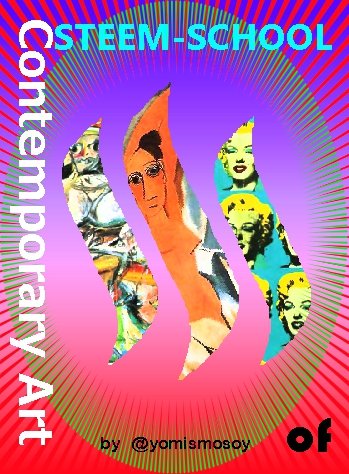STEEM-SCHOOL OF CONTEMPORARY ART. 2nd Lesson: The Aesthetic Evolution of Bauhaus, from Expressionism to Neoplasticism

Erich Consemüller: Bauhaus Scene. A Bauhaus woman sitting in a Marcel Breuer's "Wassily" Chair, wearing a theatrical mask made in metal by Oskar Schlemmer and a dress designed by Lis Volger-Beyer. Silver gelatin, near 1926. Source
Hello, my eSTEEMed students of the #steem university:
On the occasion of starting a new year in #steemit, in which I hope to cease the constant blackouts, Internet failures and all other serious problems that affect my #venezuela, here I am--
Due to a strong fall that I suffered and that affected my lips and my mouth a lot I am coming out to the air a little late. However, here is the second lesson of the STEEM-SCHOOL OF CONTEMPORARY ART, an initiative that I will take with the hope of contributing to give value to our platform through the creation of a permanent space for training in relation to Contemporary Art, and, hopefully, so that more and more Steemians dare to develop innovative and creative projects within the many alternatives offered by the new paths of art.
Here is the first lesson: Bauhaus, one hundred years of a great creative explosion that changed our lives
2nd Lesson: The Aesthetic Evolution of Bauhaus, from Expressionism to Neoplasticism
During its early years, the Bauhaus, an artistic training centre founded in 1919 in Weimar, Germany, under the direction of the German architect, urban planner and designer Walter Gropius, had the seal and influence of a group of painters from an artistic movement born a few years earlier known as Expressionism, particularly those organized around two currents such as Der Sturm, The Storm, and Der Blaue Reiter, The Blue Rider. However, a second stage is clearly announced with the incorporation of the Hungarian constructivist artist László Moholy-Nagy (1895-1946), in 1923, thus initiating a "functionalist" phase in the evolution of the Bauhaus, in which art is tested as to its "applicability", its "usefulness", and entered the service of industrial design. This was essentially contributed to by an aesthetic trend called De Stijl, The Style, which was made known at the Bauhaus by lectures by Theo Van Doesburg.
The creative impulses that arose from the Bauhaus were extraordinary and maintain their effects until nowadays. Faithful to the spirit that moved them to renew life through art without dragging the overwhelming ballast of tradition, the directors, teachers and the students themselves were able to remain open to the creative impulse of a new century that began full of hopes and innovative ideas.

Otto Umbehr: Assessment of work from Albers’s Preliminary Course. Photography, 1928. The Joseph and Anni Albers Foundation Source
The very name Gropius gave to the centre, Bauhaus, clearly expressed the intention to connect with the spirit of the traditional "Bauhütte", workshops of medieval cathedrals, in which no distinction was yet made between arts and crafts, and in which all arts were complemented under the predominance of architecture. In the founding manifesto of April 1919, Walter Gropius proclaimed to his team: "Let us all undertake together the construction of the future, in which everything will have a single semblant - architecture, sculpture and painting - and will reach the sky pushed by millions of artisan hands at the same time, as a crystalline symbol of a new and hopeful faith".
And that new faith was represented by a series of avant-garde movements including Der Sturm, which was founded in 1910 by Herwarth Walden, whose real name was Georg Lewin. This active artist and cultural promoter edited an art magazine entitled "Der Sturm", opening a gallery with the same name two years later. Both the magazine and the gallery soon became the most important German collective spokesperson for avant-garde art, providing spaces for creators of different styles and trends.

Cover of the January 1912 issue of Der Sturm magazine. Source
Artists such as Wassily Kandinsky and Franz Marc took part in the editing of the periodical, which in its first issues reproduced the first works of Oskar Kokoschka, who would become a leading figure of Expressionism and every month included many graphic and written reproductions of artists linked to two German expressionist movements such as Die Brücke and Der Blaue Reiter, as well as works, manifestos and texts translated from Italian futurists, French cubists, and any novel proposal, so that this publication reported extensively on the international art world of the time. At the same time, the exhibition activity developed by the gallery was significant, one of the highlights of which was the "First German Autumn Salon", prepared by Walden, which took place in 1913, with international participation.

Wassily Kandinsky: Der Blaue Reiter (The Blue Rider), 1903, oil on canvas, 52.1 x 54.6 cm, Stiftung Sammlung E.G. Bührle, Zurich. Source
Around the same time, in 1912, Wassily Kandinsky and Franz Marc co-edited an Almanach to explain to the public the secessionist opinions of a group of artists, under the title Der Blaue Reiter, referring to a painting painted by Kandinsky in 1903. This publication, in turn, took its name from an exhibition in which the painters Kandinsky, Gabriele Münter, his disciple and companion; Franz Marc, Alexei von Jawlensky and his wife, Baroness Marianne von Verefkin; Adolf Erbslöh; Alexander Kanoldt, Alfred Kubin, the French cubist Henri Le Fauconnier exhibited their works. Paul Klee, who was not a direct member, but was close to the group, August Macke and Arnold Schönberg, better known as musician, composer and father of dodecaphonic or twelve-tone music.

Cover of the almanac Der Blaue Reiter, 1912. Source

Franz Marc: Der Traum, 1911. Oil on canvas. 100,5 cm. X 135,5 cm. Thyssen-Bornemisza Museum, Madrid. Source

Marianne von Verefkin: Self-portrait 1, circa 1908-1910. Tempera on paper, 51 x 34 cm. Munich, Städtische Galerie im Lenbachhaus. Source
Der Sturm's and Der Blaue Reiter's renovating sense, internationalist character, new approaches to form and color found resonance and fertile ground a few years later when Bauhaus was born as the foundation of a radical educational reform that sought to develop a social structure of the very idea of creativity. It was so significant the echo that these voices reached in the new school that Kandinsky, Klee, Jawlensky and Feininger, linked to these movements, were invited and incorporated as professors in the Bauhaus of Weimar.
But at the end of the second decade of the twentieth century, a new artistic current would emerge that sought to cleanse art of all that was not essential and that, as the twenties progressed, took on great relevance in the philosophy of Bauhaus itself, in particular, from the inclusion in the teaching list of Moholy-Nagy in 1923. In 1917 he founded Theo Van Doesburg in Holland, with the architect J.J.P. Oud and the painter Piet Mondrian, the magazine De Stijl, which presented the principles of an artistic movement of the same name, strictly abstract and functional whose theoretical foundations were first conceived by Mondrian, in parallel with Kasimir Malevich, creator of the theory of Suprematism.

Piet Mondrian: Composition II in Red, Blue, and Yellow, 1930. Oil on canvas. 86 x 66 cm. Private Collection. Source
Mondrian developed, especially for painting, a system of pure geometric forms based on the simplicity of the elementary proportions in which the lineature is reduced to horizontal and vertical, and to the primary colours -red, yellow and blue-, as well as to the non-colours -white, black and grey. These approaches, condensed by Mondrian in his Theory of Pure Functional Abstraction, which was a logical continuation of Cubism, aspired to an autonomous ordering of art in order to achieve a precise perception of the regular, the constructive and the functional, far from individual subjectivity, and were quickly transferred to architecture and design by Neoplasticism.
Mondrian's functionalism was reformulated by Van Doesburg under the proposition of "organic elementarism", according to which architectural construction must be developed from the configuring elements of architecture, such as function, volume, surface, time, space, light, colour and material, applied to a rational construction procedure adjusted to the conditions of the environment and purpose. In this way, the harmonious order and rational planning of the De Stijl became the guidelines of neoplasticist architecture and design, which achieved international prestige. Many of these ideas were taught within the classrooms of the Bauhaus, either directly by some of its proponents, or by followers of them.

Theo van Doesburg: Cinebal, Dancing Hall and Cinema, 1928. Reconstruction at the Aubette, Strasbourg. Source
As can be deduced, what has been called the Bauhaus style is in reality a summation, an evolution of diverse tendencies, schools and visions that on art, architecture and design were presented in a historical and social context as effervescent as was Europe at the beginning of the 20th century, marked by the emergence of no more and no less than two world wars. Certainly Bauhaus had the great merit of having been a well-organized space in which free debate, experimentation and the dissemination of new ideas constituted the very reason for being of a great effort in terms of training the artists of the century that was beginning.

Well, let's finish our lessons for today... With the STEEM-SCHOOL OF CONTEMPORARY ART we will be able to discover a great variety of proposals within what has been the evolution of the artistic disciplines since the 20th century until today.

Of course, a vote of yours or a reblogging will serve as a stimulus and will be very grateful.

https://www.deepl.com/ helps me with traslation
I recommend you to visit the Taschen website
https://www.taschen.com/
 | |||||||||||||
|---|---|---|---|---|---|---|---|---|---|---|---|---|---|
 @yomismosoy @yomismosoy
|
   |




)
Wait you really did fall? I am so sorry. I thought you were joking.
Sending you a !Tip 2.0 to help you feel like smiling again. I'll be back to read this when I have more time.
No, it wasn't a joke... I fell entering the subterranean because there was a large layer of mud... I intend to write something about it to talk about the mixture of negligence and solidarity that Venezuela has become... Thank you for your generosity...
🎁 Hi @yomismosoy! You have received 2.0 STEEM tip from @melinda010100!
@melinda010100 wrote lately about: Wednesday Walk Feel free to follow @melinda010100 if you like it :)
Sending tips with @tipU - how to guide :)
Excellent post. The Bauhaus has such an important role in the history of Design. Do you have plans to cover the Ulm School too?
Posted using Partiko Android
Thank by your positive commentary... Yes, of course, because the Ulm School of Design is so important as Bauhaus could be. But next lessons I'll try with the first movements of all that crazy thing of modern art, keeping a chronological order... It must Fauvism or something like that... :-)